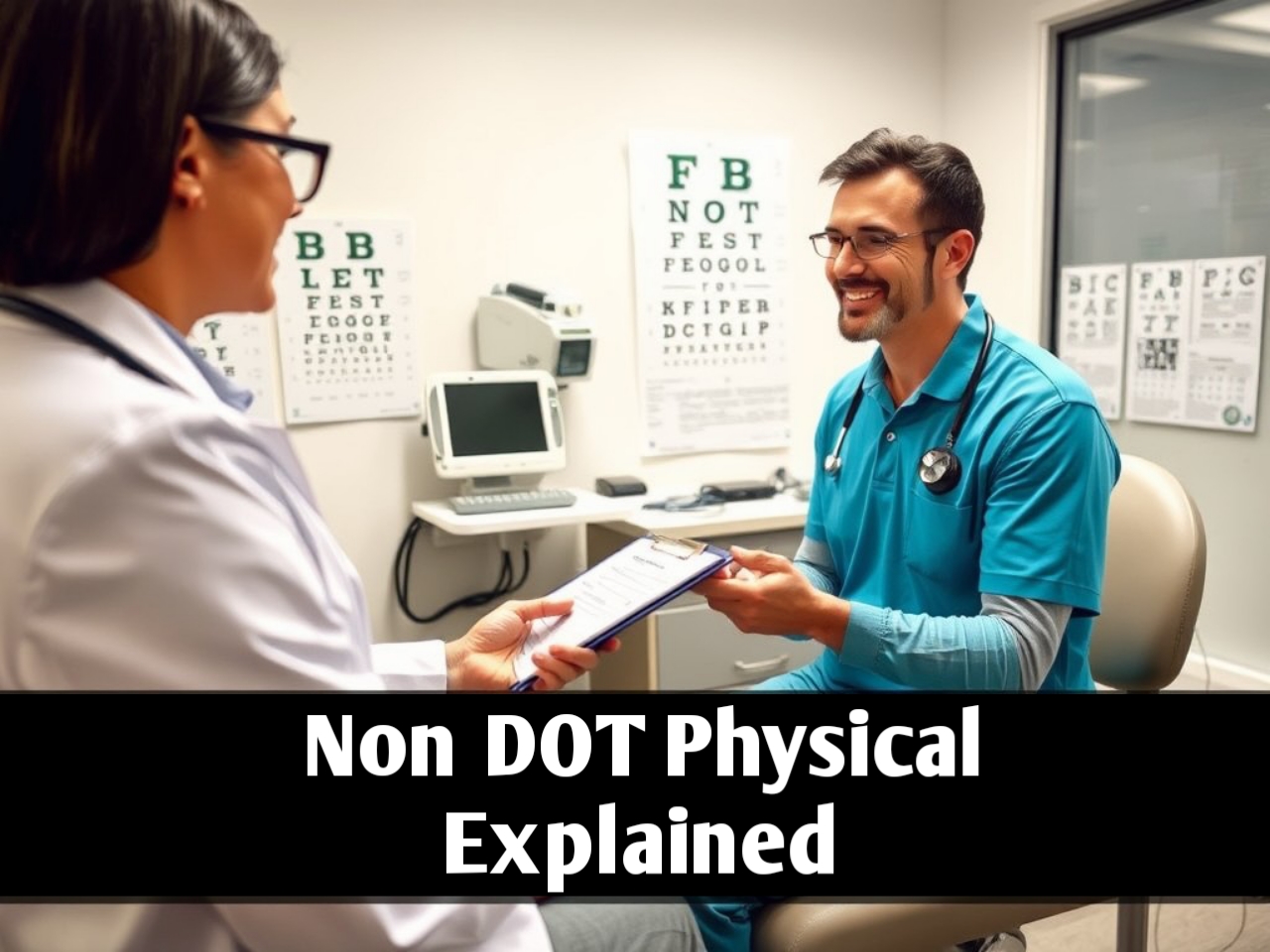Everything You Should Know About a Non Dot Physical
A Non DOT Physical is an essential medical evaluation for employees whose job roles do not fall under the Department of Transportation (DOT) regulations. Unlike DOT physicals, which are standardized to ensure the safety of commercial drivers, non-DOT physicals are tailored to meet the unique health requirements of other industries. In this comprehensive guide, we will explore everything you need to know about non-DOT physicals, including their purpose, process, requirements, and significance.
What is a Non DOT Physical?
A Non DOT Physical is a medical examination designed for employees in industries not regulated by the Department of Transportation. These physicals are typically required by employers to ensure that their workforce is physically and mentally fit for specific job functions.
Unlike DOT physicals, which are federally regulated and follow strict guidelines, non-DOT physicals can vary depending on the employer’s needs and the industry’s demands. Common sectors requiring non-DOT physicals include healthcare, construction, manufacturing, and education.
The focus of a non-DOT physical is to evaluate the employee’s ability to perform their job safely without risk to themselves or others. This often includes assessments of overall health, vision, hearing, and sometimes drug testing or specific functional ability tests.
Why Are Non DOT Physicals Important?
The primary purpose of a Non DOT Physical is workplace safety. Employers need to ensure their employees are capable of handling the physical and mental demands of their roles. Here’s why these exams are crucial:
- Prevention of Workplace Accidents: Identifying health issues early can prevent on-the-job accidents.
- Employee Health Monitoring: Regular physicals help track an employee’s health over time.
- Compliance with Company Policies: Many companies mandate physical exams to comply with internal safety standards.
- Tailored Assessments: Non-DOT physicals allow for customized evaluations based on specific job requirements.
Who Needs a Non DOT Physical?
Not all employees require a Non DOT Physical, but there are several scenarios where such evaluations are necessary:
- Pre-Employment Screening: Many employers require a non-DOT physical before offering a job to ensure the candidate is fit for the position.
- Post-Injury or Return-to-Work Evaluation: After an injury or prolonged absence, a physical ensures the employee can safely return to work.
- Annual Health Checks: Some industries mandate yearly physicals to monitor ongoing health.
- Special Job Requirements: Positions involving heavy lifting, exposure to hazardous materials, or operating machinery often require periodic health evaluations.
What Does a Non DOT Physical Include?
A Non DOT Physical may vary depending on the employer’s requirements, but it generally includes the following components:
1. Medical History Review
The doctor or medical professional will ask questions about your medical history, including:
- Chronic illnesses
- Past surgeries or hospitalizations
- Family medical history
- Current medications
This step helps identify any underlying conditions that may affect job performance.
2. Physical Examination
A comprehensive physical exam assesses overall health and typically includes:
- Checking vital signs (heart rate, blood pressure, temperature)
- Examining the respiratory and cardiovascular systems
- Testing reflexes, balance, and coordination
3. Vision and Hearing Tests
Clear vision and hearing are critical for many job functions. The test includes:
- Eye exams with and without corrective lenses
- Hearing assessments using audiometry tests or basic screenings
4. Mobility and Strength Tests
For physically demanding jobs, mobility and strength tests may be conducted to ensure the employee can handle job tasks like heavy lifting or extended standing.
5. Drug and Alcohol Testing
Though not always required, some employers include drug and alcohol tests to ensure workplace safety and compliance with company policies.
6. Specialized Tests
Depending on the role, additional evaluations may include:
- Respiratory function tests for jobs involving exposure to hazardous materials
- Bloodwork or urine tests for specific conditions
How is a Non DOT Physical Different from a DOT Physical?
While both physicals aim to ensure workplace safety, there are significant differences between DOT and non-DOT physicals:
| Aspect | DOT Physical | Non DOT Physical |
|---|---|---|
| Regulation | Federally regulated by the FMCSA | Employer or industry-specific |
| Scope | Standardized across the U.S. | Customizable based on employer |
| Frequency | Typically every 2 years | Varies by employer or job role |
| Purpose | For commercial drivers | For non-DOT-regulated employees |
Preparing for a Non DOT Physical
Preparing for a Non DOT Physical is straightforward, but taking a few proactive steps can make the process smoother:
- Bring Necessary Documentation: Carry identification, medical history, and a list of medications.
- Follow Pre-Exam Instructions: If your employer has specific guidelines (e.g., fasting), follow them carefully.
- Wear Comfortable Clothing: Opt for attire that allows easy movement for mobility tests.
- Be Honest: Provide accurate information about your health and lifestyle.
Common Questions About Non DOT Physicals
1. How Long Does a Non DOT Physical Take?
The duration of the physical depends on the complexity of the tests but typically lasts 30 to 60 minutes.
2. Is It Covered by Insurance?
Some non-DOT physicals may be covered by insurance, but this largely depends on the employer’s policies and the employee’s insurance plan.
3. What Happens if You Don’t Pass?
Failing a non-DOT physical doesn’t necessarily mean losing your job. Employers may provide accommodations, assign alternative tasks, or require further evaluations.
Benefits of Regular Non DOT Physicals
Regular Non DOT Physicals provide numerous advantages for both employees and employers:
- Early Detection of Health Issues: Routine checkups can catch health problems early.
- Improved Employee Productivity: Healthy employees are more productive and have fewer absences.
- Enhanced Workplace Safety: Regular monitoring reduces the risk of accidents.
- Lower Healthcare Costs: Preventive care is often less expensive than treating advanced health conditions.
How Employers Can Streamline Non DOT Physicals
Employers play a crucial role in facilitating non-DOT physicals. Here are a few strategies to ensure smooth implementation:
- Partner with Reliable Clinics: Choose healthcare providers experienced in workplace evaluations.
- Standardize Requirements: Clearly communicate the physical exam criteria to employees and providers.
- Provide Resources: Offer support like pre-exam instructions and time off for appointments.
Conclusion
A Non DOT Physical is a valuable tool for maintaining workplace safety and ensuring employees are fit for their roles. Tailored to meet specific job requirements, these exams protect both the employee and the employer from potential risks. Whether you’re an employee preparing for a physical or an employer establishing health policies, understanding the purpose and process of non-DOT physicals is essential.
By prioritizing these evaluations, businesses can foster a healthier, safer, and more productive work environment.
Read Also Our This Post: Discover Mega-Personal.net Health Archives: Essential Reads for Better Health







